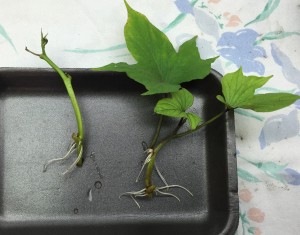
In my earlier post Growing Sweet Potatoes in the North, I described how to grow short-season sweet potatoes in a northern Zone 3-2b garden. I also mentioned overwintering the vines for the next season.
This is a very easy process and you can bring these slips into the house for the winter, and treat them the same as you would any other pretty houseplant while you wait for warmer weather. If you read my previous post, you will notice the process is almost identical to what I do in spring, except on a smaller scale.
Growing new vines from cuttings is much easier than trying to grow shoots from the tubers themselves, and cheaper than buying new slips and stock each spring. Growing from cuttings is done by taking a cutting from the vine at harvest, rooting it in some water, and planting it in some potting soil for the winter. The bonus with taking cuttings is, all the tubers you grew can be eaten. And a second hidden bonus is, often the overwintered vines will grow tiny sweet potatoes over the winter months, and you get to harvest these again in the spring when you prepare fresh cuttings and vines for your summer season!
There are a couple things to consider.
- Use loose soil so the vines have a chance to grow healthy roots, and possibly even tiny tubers.
- Make sure you give the vines enough nutrient in the soil to stay healthy and growing
- Plant the vines when the roots are not very long, to prevent them from being coiled and preventing tubers from developing.
- Keep the pots in a warm area with enough light, so they don’t try to go dormant or the vines think they need to die-off for winter.
In this (slightly blurry) recorded Periscope broadcast video, I discuss the process I use for overwintering sweet potato vines.
I’m always happy to answer questions, or hear your thoughts in comments. Have you grown Sweet Potatoes in the North? Had luck?



Thank you!
Hi! I run a small organic farm in California and wondering if you could help me with a problem: I bought two acres worth of sweet potato slips but, one farm/equipment disaster after another and I missed my opportunity to plant them this year. They’re currently heeled together in one big ditch in our rich farm soil and growing large and bushy. I’d like to overwinter them so I can plant next year , but it isn’t practical to store so many individually in pots. What are your thoughts about my building a small hoop house over the plants and trying to keep them for next spring? Or any other ideas/tips on how to keep them alive?
Thanks in advance for your help, and if you could respond via email or phone that would be great! My name is Dani and I’m a young farmer who could use all the help I can get.
Looking forward to hearing back,
does it matter where on the vine that you take the cuttings from?
I haven’t found that it matters, as long as the section you choose is healthy. I generally prefer the growing end, but that may just be preference. They have all seemed to perform equally once rooted 🙂
Can these be stored in the refrigerator till spring. I’ve got a few coils in a box in the refrigerator
Hi Bill,
My assumption is the slips/vines will not store in the fridge since they die off from the tuber in cold/dark fall conditions. You will need to root them and plant them and provide them light and decent room temperature to keep them alive.
Will they rot if stored in the refrigerator?
Can they be touching while rooting?
Hi Bill,
There is absolutely nothing wring with having the vines touching while rooting them in water 🙂 That is how I normally do it to save space, then I plant the strongest ones to keep through winter.
My experience growing sweet potatoes in the North has been an adventure from the start. In March of 2018 I was housesitting for a friend and lo and behold the sweet potato in her pantry was sprouting! I took it home, propped it in some water, and waited for it to grow. It grew really slowly but eventually I was able to take slips off of it and root and plant them. I put them in the biggest flower pots I could find because by this time it was September and winter was on its way. They’ve continued to grow throughout the winter, and they seem healthy for the most part but I don’t think I’ll ever be able to move them outside because our zone is too cold. What signs should I look for to tell me if there’s tubers that I can harvest? Because it’s growth is slow and stunted I know I can’t judge by time, but I’m hungry for some sweet potatoes!
I just pulled my potato vines from my flower pot and dug out huge potatoes. Can I plant these in February in pots to grow new potato vines.
If you can give them the right conditions, you can always plant them into pots for more vines. What I find best though when starting from a tuber itself is to start them like an avocado pit. Suspended part in and part out of water. Once the new vines are large enough with their own roots, I remove them from the tuber and plant those.
Hi, I grow a sweet potato vine for decorative purposes. During the spring and and summer it was growing very nicely with green leaves, but now that the temperatures are gradually decreasing, it stopped growing new leaves, with current leaves turning yellow-ish. The growing part of some of the vines has also turned brown/dry. Is this behavior normal? Will it re-grow after the winter, or do I need to do something before it dies?
Thanks!
THANK YOU for the great article and helpful advice! I am starting a sprouted Vardaman sweet potato (gift from MS relatives) and I have some saved slips from Beauregard that I planted too late. With your advice, I may be able to make it to spring with 2 varieties.
Why can you not plant the whole plant out in the spring? I understand you take cuttings and harvest the small potato’s. I was hoping to keep them in smaller pots and plant the whole thing out in the spring
Hello Alexis. It depends on your intention. If you only are interested in a vine, then you can certainly bring the entire plant in, and put it back out again in spring. If your intention is to grow a new crop of tubers, it will need new roots to do that with, so needs to be done from rooted cuttings or rooted shoots. The roots from the previous year will have already set their tubers, and will likely not grow a new crop, nor continue to enlarge much.
I know this post is rather old… but I’m hoping you’re still there!
I cut vines from my sweet potato plants at harvest time and stuck them in water. They grew like crazy and I decided to try to over winter them in pots with soil. (oh, and they’re under plant lights) They are still alive! But… some of the leaves are turning yellow with dry brown edges. The soil feels damp, not wet. I’m guessing I don’t have the watering quite right. What do you think?
Thanks for all the good info!
I’m not a novice gardener, however I’ve never grown my own potatoes. I purchased some sweet potato & red potato slips recently. It’s winter here now. Can i store those in a planter pot in soil (inside) till planting time in Spring? If so, what temp does the home need to maintain them till spring? Thanks so much!